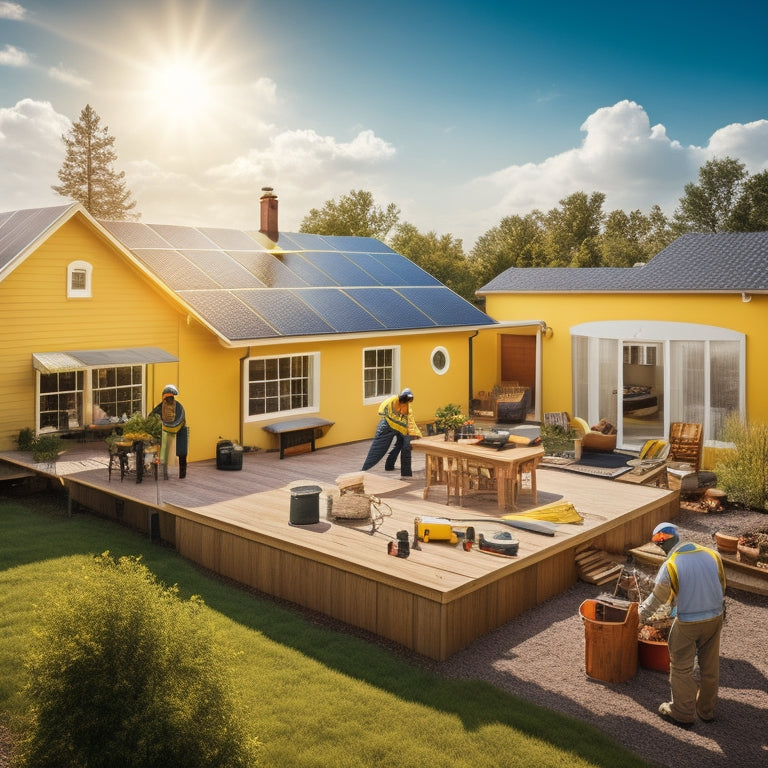
Solar Electricity Installation in 10 Simple Steps
Share
You're about to utilize the power of solar energy, and it starts with evaluating your energy needs by reviewing past utility bills and considering seasonal variations, appliance usage, and potential energy-efficient upgrades. Next, choose solar panels that balance efficiency with cost, and select a mounting system that secures them for ideal energy harvesting. Plan electrical connections, prepare your roof structure, and connect to inverters safely. Link your system to the grid or battery, test and inspect it, and finally, monitor and maintain its performance. As you follow these 10 simple steps, you'll be well on your way to reducing your reliance on the grid - and there's more to investigate in the world of solar electricity installation.
Key Takeaways
- Assess energy needs by reviewing past utility bills and considering seasonal variations, appliance usage, and energy-efficient upgrades.
- Choose solar panels that balance efficiency with cost, and select a mounting system that secures panels for optimal energy harvesting.
- Ensure electrical connections are safe and compliant with voltage, current, and grounding requirements, and create a detailed electrical diagram.
- Obtain necessary installation permits, comply with local regulations, and conduct a shading analysis to identify obstructions affecting solar panel performance.
- Test the system to verify voltage and current output, and monitor performance regularly to ensure maximum electricity generation and troubleshoot issues.
Assess Your Energy Needs
Frequently, homeowners overlook the crucial step of evaluating their energy needs before installing a solar electricity system. You must determine your energy consumption patterns to guarantee a suitable system size.
Start by reviewing your past utility bills to identify your average daily energy usage in kilowatt-hours (kWh). Consider factors like seasonal variations, appliance usage, and potential energy-efficient upgrades. This assessment will help you decide on the right system capacity to meet your energy needs.
You'll also want to investigate available solar incentives, such as net metering, tax credits, and rebates, which can greatly impact your system's cost-effectiveness.
Understanding your energy consumption patterns and available incentives will enable you to design a solar electricity system that maximizes your savings and reduces your reliance on the grid.
Choose a Solar Panel Type
Your solar electricity system's performance hinges on the type of solar panels you choose, as they directly impact the amount of energy your system generates.
You'll want to select solar panels that balance efficiency with cost. Currently, monocrystalline silicon solar panels offer the highest solar panel efficiency, but they come at a higher price point. Polycrystalline silicon solar panels are a more affordable option with slightly lower efficiency. Thin-film solar panels are the most budget-friendly, but their efficiency is considerably lower.
When choosing a solar panel type, consider the space available for installation and the amount of energy you need to generate.
Keep an eye on solar technology trends, as advancements are continually improving efficiency and reducing costs. Look for solar panels with high-efficiency ratings, low temperature coefficients, and sturdy warranties.
Be sure to research and compare different brands, models, and features to find the best fit for your solar electricity system. By selecting the right solar panels, you'll maximize your energy output and enjoy a strong return on investment.
Select a Mounting System
You'll need to select a mounting system that securely fastens your solar panels to your roof or ground, ensuring ideal energy harvesting and durability.
You'll have to choose from various roof mounting options, such as flush mounts, tilt mounts, and rail-based systems, each with its own set of benefits and drawbacks.
Additionally, you'll need to evaluate types of racking systems and ground mounting methods that suit your specific installation requirements.
Roof Mounting Options
When selecting a roof mounting system for your solar electricity installation, considering the type of roof you have is vital. The roof's material, age, and condition will impact the type of mounting system you choose.
You'll want to ascertain the mounting system is compatible with your roof material, whether it's asphalt shingles, metal, clay tiles, or something else.
The orientation of your solar panels is also significant, as it affects energy production.
Consider the following roof mounting options:
- Flush mounting: ideal for roofs with a shallow pitch or limited space
- Tilt mounting: allows for adjustable solar panel orientation
- Rail-based mounting: provides flexibility for future panel additions
- Ballasted mounting: suitable for flat or low-slope roofs
- Standoff mounting: provides clearance for roofs with obstructions or complex design
Types of Racking Systems
Selecting a suitable racking system is a vital step in guaranteeing a secure and efficient solar electricity installation. You'll need to evaluate the type of racking system that best suits your roof's dimensions, material, and structural integrity.
There are two primary types of racking systems: fixed-tilt and tracking systems. Fixed-tilt systems are the most common, offering a cost-effective solution with minimal maintenance requirements. They're ideal for roofs with limited space or obstructions.
Tracking systems, on the other hand, adjust to the sun's movement, maximizing energy output. However, they're more expensive and require regular maintenance to guarantee peak performance.
When choosing a racking system, reflect on the racking materials, installation techniques, and system durability. Weather resistance is essential, as it directly impacts the system's lifespan.
Compare the cost of different systems, assessing the benefits of each against your budget. Additionally, evaluate the maintenance requirements of each system, making sure you're prepared for any future upkeep.
Ground Mounting Methods
Ground mounting methods offer an alternative to rooftop installations, providing more flexibility regarding system design and layout.
When selecting a ground mounting system, you'll need to take into account several factors to guarantee a successful installation.
-
Ground stability: Assess the soil's ability to support the weight of the system and withstand environmental factors like wind and water.
-
Soil analysis: Conduct tests to determine the soil's composition and density, which will impact the type of mounting system you choose.
-
Installation permits: Obtain necessary permits and approvals from local authorities before commencing the installation.
-
Site accessibility: Ascertain the site is easily accessible for maintenance and repair, considering factors like road access and terrain.
-
Drainage considerations: Plan for proper water drainage to prevent water accumulation and potential system damage.
Plan Electrical Connections
You'll need to plan the electrical connections for your solar electricity installation carefully to guarantee a safe and efficient system. This involves identifying the correct connection types for your solar panels, inverters, and electrical panels. Verify you understand the electrical safety requirements for each component, including voltage, current, and grounding requirements.
Determine the type of electrical connections required, such as MC4 connectors for solar panels or IP65-rated connectors for outdoor use. Verify the compatibility of connections between different components, like the inverter and electrical panel.
Consider the cable sizing and length required to connect the solar panels to the inverter and electrical panel. Create a detailed electrical diagram or schematic to visualize the connections and identify potential issues.
This will help you verify that your system meets electrical safety standards and operates efficiently. By planning your electrical connections carefully, you can avoid costly mistakes, verify a safe installation, and maximize your solar electricity generation.
Prepare Your Roof Structure
With your electrical connections planned, it's now time to turn your attention to preparing your roof structure for the solar electricity installation. This step is vital to guarantee a safe and efficient installation.
You'll need to assess your roof's condition to confirm it can support the weight of the solar panels. Reflect on the following factors:
-
Roof maintenance: Check for damaged, missing, or loose tiles, and repair or replace them as needed.
-
Structural integrity: Verify that your roof's framing can handle the added weight of the solar panels and withstand natural elements like wind and snow.
-
Weather resistance: Ascertain your roof is waterproof and can withstand extreme temperatures, as solar panels will be exposed to the elements.
-
Insulation requirements: Check your attic insulation to verify it meets local building codes and won't interfere with the solar panel installation.
-
Shading analysis: Identify any obstructions, such as trees or neighboring buildings, that might affect the solar panels' energy output.
Remember to obtain the necessary installation permits and comply with local safety regulations and design aesthetics.
It's also essential to reflect on future expansions and your roof's load capacity to guarantee a successful solar electricity installation.
Install Solar Panels Securely
Now that your roof structure is prepared, it's time to focus on securely installing your solar panels.
You'll want to make certain that your solar panels are installed in a way that maximizes their durability and efficiency. Start by carefully unpacking and inspecting your solar panels for any damage or defects.
Next, lay out the panels on your roof according to the manufacturer's instructions, taking care to maintain the recommended spacing and alignment. Secure each panel to the roof using the provided mounting hardware, making sure to follow the manufacturer's torque specifications and installation guidelines.
It's essential to verify that the panels are securely fastened to withstand wind, rain, and other environmental factors.
Remember to always prioritize installation safety, wearing appropriate personal protective equipment and following proper lifting and handling procedures.
Connect to Inverters Safely
Connecting your solar panels to inverters is a crucial step in utilizing the power of the sun, and it's important to do so safely to avoid electrical shock, fires, and other hazards.
You'll need to choose the right inverter type for your system, such as string inverters, microinverters, or power optimizers.
When connecting to inverters, make certain to follow these safety measures:
- Wear protective gear like gloves and safety glasses to prevent electrical shock
- Confirm the inverter is installed in a well-ventilated area to prevent overheating
- Keep the inverter away from flammable materials to reduce fire risk
- Ground the inverter and solar panels to prevent electrical shock
- Follow the manufacturer's instructions for connecting the inverter to your solar panel system
Link to Grid or Battery
You've successfully connected your solar panels to an inverter; the next step is to decide how to employ the generated electricity. You have two options: link your system to the grid or store excess energy in a battery. Grid integration allows you to sell excess energy back to the utility company and offset your electricity bills. On the other hand, battery storage provides backup power during outages and enables you to use stored energy when the sun isn't shining.
Here's a comparison of the two options:
| Option | Advantages | Disadvantages |
|---|---|---|
| Grid Integration | Offset electricity bills, potential revenue | Grid dependence, potential blackouts |
| Battery Storage | Backup power during outages, energy independence | Higher upfront cost, limited capacity |
| Hybrid System | Combines benefits of both, flexible energy usage | Higher complexity, increased maintenance |
| Off-Grid System | Complete energy independence, no grid reliance | Limited scalability, high upfront cost |
| Energy Monitoring | Real-time energy tracking, optimized usage | Additional hardware cost, data analysis required |
Consider your energy needs, budget, and preferences to decide which option best suits your solar electricity installation.
Test and Inspect System
With your solar electricity generation system configured, it's time to verify that it's functioning as intended.
You've invested a significant amount of time and resources into this project, and it's vital to confirm it's performing at its best and safely.
To do this, you'll need to test and inspect your system. This involves checking the system's performance, confirming it meets safety regulations, and identifying any potential issues.
Here's what you should check:
- Voltage and current output to verify they match the system's design specifications
- Inverter operation to check it's converting DC power to AC efficiently
- Grounding and bonding to confirm the system is safely grounded
- Electrical connections to verify they're secure and meet safety standards
- System monitoring to confirm it's providing accurate data on performance and energy production
Monitor and Maintain Performance
Every solar electricity generation system requires regular monitoring and maintenance to guarantee peak performance and extend its lifespan. You'll want to keep track of your system's performance to make certain it's generating the maximum amount of electricity possible.
Performance monitoring involves tracking your system's energy output, identifying areas for improvement, and making adjustments as needed.
For maintenance tips, start by checking your inverter regularly to verify it's functioning correctly. Keep your solar panels clean and free of debris, as dirt and dust can reduce efficiency.
Efficiency tracking is vital, so you can identify any issues and make adjustments. Troubleshooting guides can help you identify and fix common problems.
Consider system upgrades if your energy needs change over time. Weather considerations, such as seasonal changes, can affect your system's performance, so be prepared to adjust accordingly.
Frequently Asked Questions
Can I Install Solar Panels on a Metal or Tile Roof?
You can install solar panels on both metal and tile roofs, but you'll need to take into account metal roof's structural integrity and potential rust, while tile roofs offer benefits like easy panel removal and replacement of individual tiles if needed.
How Long Does a Typical Solar Installation Take to Complete?
You'll typically spend 2-5 days on a solar installation, broken into project phases like assessment, permitting, and installation. Your installation timeline may vary depending on factors like system size, roof complexity, and local permits.
Are Solar Panels Resistant to Hail and Extreme Weather?
You'll be relieved to know that 99.99% of solar panels survive hail storms unscathed! Modern solar panels are designed to withstand extreme weather, with tempered glass and sturdy frames that minimize hail damage, ensuring reliable energy generation despite weather durability concerns.
Can I Add More Solar Panels to My Existing System Later?
You can expand your solar panel setup later, but you'll need to guarantee system compatibility; consider your existing inverter's capacity, electrical connections, and roofing structural integrity before adding more panels for a seamless solar panel expansion.
Do Solar Panels Void My Roof Warranty?
Don't worry, you won't necessarily void your roof warranty; you'll just need to guarantee the solar panel installation is done correctly and in compliance with the warranty terms, so you can utilize that power without worrying about the roof above.
Conclusion
You've finally reached the finish line, and your solar electricity installation is ready to shine like the sun it captures! Now, as you bask in the glow of renewable energy, remember that "Rome wasn't built in a day." Your diligence in following these 10 simple steps has paid off, and your system will continue to generate clean power for years to come. Keep monitoring and maintaining its performance, and you'll be reaping the rewards of your hard work for a long time.
Related Posts
-

Solar Power Backup Solutions During Outages
Solar power backup solutions guarantee you have reliable energy during outages, providing essential power when the gr...
-

High-Performance Energy-Efficient HVAC Systems
High-performance energy-efficient HVAC systems are essential for reducing energy consumption while improving indoor c...
-

How to Reduce Home Energy Bills
To reduce your home energy bills, start by investing in energy-efficient appliances and upgrading your insulation. Lo...


